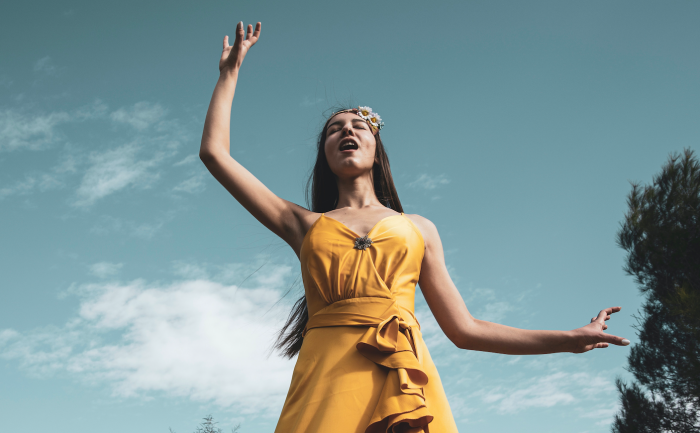Have you discovered your inner wild woman yet?
Usually, I don’t feel the need to experiment much with my hair, but recently I felt a strange urge to do so.
I’ve noticed that women often change their hairstyle when they’re undergoing some form of significant transformation. For example, going through a breakup in a relationship or becoming a mother. There wasn’t much that had changed externally in my life, yet internally I felt different.
Currently, what are the rites of passage that symbolize significant change?
What is it that marks the transition of a girl into a woman? Is it when they turn 18 years old? When they get their driver’s license? When they get married? When they leave their parents’ house? When they lose their virginity or when they become a mother?
But what about the women who choose not to marry or have children? Maybe something as simple as the change of hairstyle is a subtle way for us to express an inner transformation or the beginning of a new cycle.
In her book, Women Who Run With The Wolves, Clarissa Pinakola Estés suggests that one of the initiations into womanhood is discovering the inner wild woman, and breaking free from constantly living up to the expectations of society.
She describes the wild woman as follows:
“She is intuition, she is far-seer, she is deep listener, she is loyal heart. She encourages humans to remain multi-lingual; fluent in the languages of dreams, passion, and poetry.” ~ Clarissa Pinakola Estes
The inner wild woman is an archetype that represents a spirit unconcerned with social conventions, hierarchies, or status; someone who is in touch with their liveliness and shares it with the world. Someone who chooses to follow their heart, rather than protecting it.
“You’ll know a wild woman when you meet one, heck you’ll feel her essence before knowing her name. They have this eccentric energy about them, one that passes by to touch the core—to awaken your own spirit to seek a little deeper, a little more.” ~ Nikki Rowe
Each woman is unique and so is the expression of her inner wild woman; it’s up to us to uncover how we want to express her within, as individuals.
What aspects of our traditional roles as women have we adopted just because we think we should and what aspects are genuinely in alignment with who we truly are?
A girl who was raised in a religious family might reject her sensuality because her family and culture see modesty as a high virtue. She might look down on other women who are wearing tight skirts or showing off their cleavage. But what is the reason behind her conviction and judgment? Is it because she genuinely doesn’t like dressing this way, or because she has disowned the aspect of herself that is sensual in order to be loved and accepted?
A similar question could be asked about a woman who is wearing sensual clothes. Is this a result of her not feeling pretty without a sexy dress and makeup or because she genuinely enjoys expressing her sensuality through what she wears?
Our Western culture has lost connection with some of its old traditions. It was Joseph Campbell who explored different tribes and their rites of passage. He explored traditions linked with initiating young people into adulthood, including traditions linked with significant transitional phases in one’s life.
A practice that is common among many traditional initiations involves separation from the parents and blindfolding the initiates at the beginning of the rites. This symbolizes the fact that they will no longer know and see what they knew and saw before. They are required to leave some form of identity behind and step into the unknown. During this process, the initiate’s focus is turned inward to his or her own wounds, which gives rise to inner transformation.
It’s somewhat similar to a cocoon phase before developing into a butterfly.
It’s not that initiations have completely disappeared from our lives, but rather the importance of initiation is no longer recognized. Perhaps there was an accident, an illness, or the loss of a loved one.
Have you ever changed your hair during the transition phase in your life? What is your expression of an inner wild woman?
I’ve recently read a beautiful poem from Sanne Burger and she inspired me to put together my own simplified version of that poem and of what inner wild woman means to me:
I wasn’t born to be put into boxes
I wasn’t born to live the same day on repeat
I wasn’t born to make myself small
I wasn’t born to follow other people’s ideas
I wasn’t born to please others
I wasn’t born to be a maid
I was born to find my own truth
and make my own rules
I was born to live life to the fullest
To get lost on adventures
To see different faces, places, and cultures
To be out in the jungle
To ride the storms
To swim in the depths of the ocean
To be heartbroken
Bruised
Lost
Exuberant
I was born to get my hands dirty
To feel Earth under my feet
I was born to dive into the infinite
I was born to feel everything
To taste everything
The bitter taste of sorrow
The sweet taste of love
I was born to experience change
I was born to learn how to speak the language of love
The language of intuition and heart
To shed everything
To let go of all expectations
I was born to live a life that would remove anything that wasn’t real
that wasn’t true
that wasn’t me
I was born to learn how to fly
I was born to be free









Read 13 comments and reply